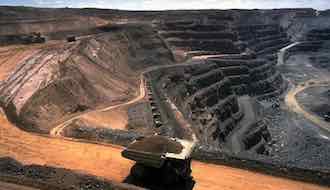Roughly two-thirds of China's power in 2030 will come form fossil energy, the vast majority from coal
China's Drive For Global Resources
 Across
the globe, on nearly every continent, China is involved in a dizzying
variety or resource extraction, energy, agricultural, and infrastructure
projects—roads, railroads, hydro-power dams, mines—that are wrecking
unprecedented damage to ecosystems and biodiversity reports, William
Laurance. 1
Across
the globe, on nearly every continent, China is involved in a dizzying
variety or resource extraction, energy, agricultural, and infrastructure
projects—roads, railroads, hydro-power dams, mines—that are wrecking
unprecedented damage to ecosystems and biodiversity reports, William
Laurance. 1It is difficult to find a corner of the developing world where China is not having a significant environmental impact. China is the world’s biggest financier and builder of hydroelectric dams, many of which are being constructed in biologically diverse regions where the dams and their associated roads and power lines will open up new lands for exploitation.
According to a major World Bank analysis of nearly 3,000 projects, Chinese foreign investors and companies often predominate in poorer nations with weak environmental regulations and controls, causing those nations to become ‘pollution havens’ for Chinese enterprises. 1
Chad is as geographically isolated as places come in Africa. It is also among the continent’s poorest and least stable countries, the scene of recurrent civil wars and foreign invasions since it gained independence from France in 1960. None of that has put off the Chinese. In January 2007 they bought the rights to a vast exploration zone that surrounds the rural village of Koudjiwai, making the baked wilderness of this location, without roads, electricity or telephones, the latest frontier for Chinese thirsty oil industry and increasing global ambitions. 2
The same is happening in one African country after another. In large oil exporting countries like Angola and Nigeria, China is building or fixing railroads and landing giant exploration contracts in Congo and Guinea.
For China, Africa represents oil and minerals to fuel employment and growth at their thousands of factories, a place to send young men to work (some say there are 500,000 Chinese workers in Africa), and a place to invest some of its excess liquidity to keep domestic inflation down.3
China’s dealings with Latin America are staggering. Its bilateral trade with Latin American and the Caribbean has simply skyrocketed, from $15 billion in 2001 to $288.9 billion in 2012—an increase of almost 2000 percent. China is now Latin America’s largest creditor. 4
Nicaragua announced that it is awarding China a contract to build an alternative to the Panama Canal. The $50 billion scheme, started in December 2014, is being built by a Chinese firm. Although Nicaragua’s government says the canal will bring vital investment, some Nicaraguans and environmentalists are opposed to construction of the canal. 5
Gaming With Pollution
No debate, China is also engaged in green activities such as investing heavily in solar and wind energy, cracking down on its notorious air pollution and replanting millions of acres of its denuded lands. But China’s burnishing of its green credentials is in many ways being overwhelmed by the sheer scale of environmental degradation that its policies and corporations are causing worldwide.Over the last decade Chinese government ministries have released a series of ‘green papers’ outlining lofty environmental and social guidelines for China’s overseas ventures and corporations. However, the Chinese government readily admits that compliance with its guidelines is poor, but accepts no blame for this. Instead, it insists that it has little control over its corporations and blames the host nations themselves for not controlling Chinese corporations more carefully. If China really wanted to reign in its free wheeling corporations, it could easily do so. 1
An example of how China plays games with pollution statistics is the past Olympics. Ahead of the Olympics, China was brandishing its report card on ‘blue sky days’ in Beijing, when measures of sulfur dioxide, nitrogen oxides and particulate matter fell below 100 on a 500 point scale- a measure that would still be considered heavy pollution in other countries. There were only 100 such days in 1998, but after pledging 245 days in 2007, the government announced that it had succeeded with 246 and was on target for the goal of 256. They helped themselves by repositioning the monitors. Two were excluded in more polluted areas and three were added in cleaner ones. One US officials said, “Instead of meeting standards, China sometimes restates standards to meet reality.” 6
In late 2014 China pledged to peak its CO2 emissions by 2030 and achieve 20% of its primary energy from non-fossil energy sources. And certainly China continues to lead the world in annual additions of wind and solar power. While these developments are to be celebrated, there remains a sobering reality: they still leave a lot of head room for China to expand its coal power plant capacity between now and 2030, even though its coal fleet is already more than twice the size of the US coal fleet.
It is important to note that despite additions of substantial wind, solar and nuclear capacity, when properly adjusted for capacity factor to reflect actual capability, the amount of new coal energy added to the China grid in 2014 exceeded solar energy by more than 17 times and wind energy by more than 4 times, and even new hydro by more than 3 times. 7
Roughly two-thirds of China’s power in 2030 will come form fossil energy, the vast majority from coal
References
- William Laurance, “The dark legacy of China’s drive for global resources,” e360.yale.edu, March 28, 2017
- Howard W. French, “China, filling a void, drills for riches in Chad,” The New York Times, August 13, 2007
- Mthuli Ncube and Michael Fairbanks, “China in Africa,” Harvard International Review, November 30, 2012
- Jose Cardenas, “China’s great leap into Latin America,” realclearworld.com, May 2, 2017
- “Nicaragua canal scheme must be dropped,” bbc.com, October 14, 2016
- David Cyranoski, “Visions of China,” Nature, 454, 384, July 24, 2008
- Armond Cohen,”No China coal peak in sight; carbon capture will be necessary to tame emissions in this century,” catf.us/blogs, February 18, 2015
 By
By
No comments:
Post a Comment